Albumin

Description: is a protein produced by the liver that circulates in plasma.
Source: Commonly found in blood plasma. Bovine serum albumin is usually used
Use: Albumin is used to replace blood volume loss resulting from trauma such as a severe burns or an injury that causes blood loss
Alternative: Genetically-modified rice are also used to reduce animal cruelty
Albumen (Egg Whites)
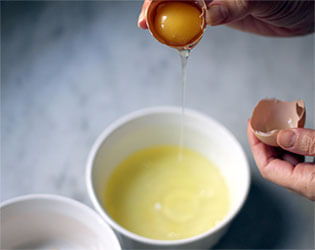
Description: In eggs, milk, muscles, blood, and many vegetable tissues and fluids. May cause allergic reaction. Derivative: Albumin.
Source: source
Use: In cosmetics, albumen is usually derived from egg whites and used as a coagulating agent. In cakes, cookies, candies, etc. Egg whites sometimes used in clearing” wines.
Gelatin

Description: A coagulant and food thickener derived from animal bones, skin and other parts containing collagen
Source: source
Use: Gelatin is used to thicken and solidify a wide range of foods, including gummy bears, fruit-flavored jello, and marshmallows
Isinglass
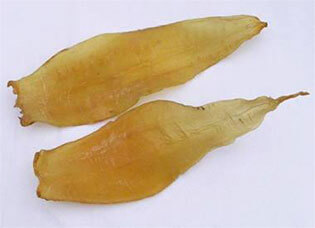
Description: It is a form of collagen
Source: Is a substance obtained from the dried swim bladders of fish
Use: Used mainly for the clarification or fining of some beer and wine
Allantoin

Description: Is a chemical compound. Allantoin is a major metabolic intermediate in most organisms including animals, plants and bacteria.
Source: It is produced from uric acid, which itself is a degradation product of nucleic acids. Is present in the urine of most mammals
Use: It is frequently present in toothpaste, mouthwash, and other oral hygiene products, in shampoos, lipsticks, anti-acne products, sun care products, and clarifying lotions, various cosmetic lotions and creams, and other cosmetic and pharmaceutical products.
Alternative: Is present in botanical extracts of the comfrey plant
Alpha-Hydroxy Acids
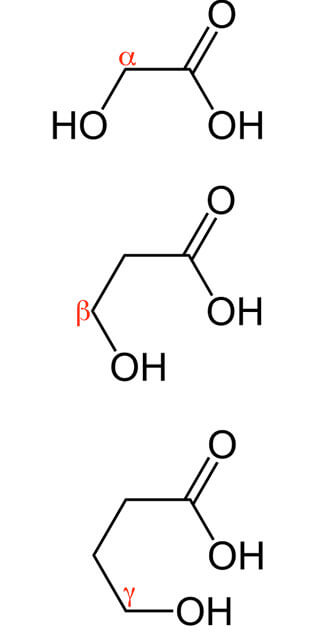
Description: are a class of chemical compounds that consist of a carboxylic acid substituted with a hydroxyl group on the adjacent carbon.
Source: Lactic acid may be animal-derived (see Lactic Acid).
Use: Any one of several acids used as an exfoliant and in anti-wrinkle products
Alternative: Glycolic acid, citric acid, and salicylic acid are plant- or fruit-derived.
Lactic Acid
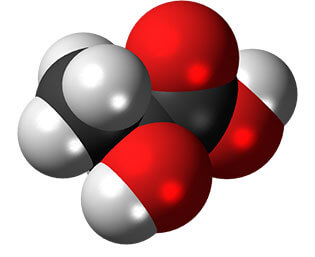
Description: Lactic acid is an organic acid. It is white in the solid state. When in the dissolved state, it forms a colorless solution
Source: Found in blood and muscle tissue. Also in sour milk, beer, sauerkraut, pickles, and other food products made by bacterial fermentation.
Use: Topical preparations and cosmetics to adjust acidity and for its disinfectant and keratolytic properties
Alternative: Plant-based milk sugars, synthetics
Beeswax
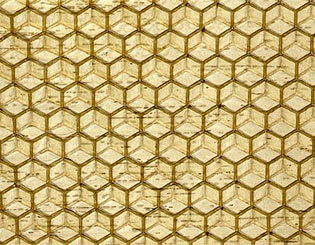
Description: Is a natural wax produced by honey bees
Source: The wax is formed into scales by eight wax-producing glands in the abdominal segments of bees
Use: Candle-making, food additive E901, Lubricate Wood, polish furniture, lip balm, water proofing agent
Bee Pollen

Description: Bee pollen is a ball or pellet of field-gathered flower pollen packed by honeybees and used as the primary food source for the hive.
Source: source
Use: health supplement, as food
Biotin
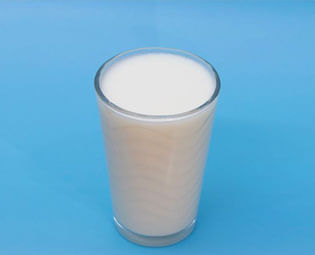
Description: Biotin is a form of vitamin B
Source: Found in larger amounts in milk
Use: Used as a texturizer in cosmetics, shampoos, and creams.
Alternative: Yeast
Carmine
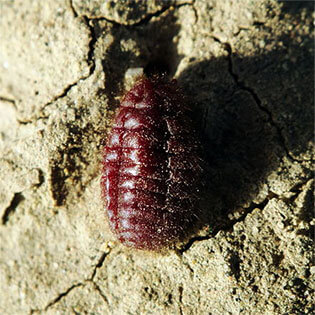
Description: Is a pigment of a bright-red color scale insects such as the cochineal, Armenian cochineal, and Polish cochineal.
Source: Carmine is made by crushing the female cochineal insect. The insects are harvested, sun-dried and crushed. They are then put into an acidic solution that produces carminic acid.
Use: coloring agent, food dye, food colorant
Elastin

Description: An animal-derived ingredient that comes from connective tissues.
Source: Protein found in the neck ligaments and aortas of cows.
Use: Often combined with collagen in beauty products.
Alternative: Synthetic alternatives may be available, protein from plant tissues.
Fish scales / Guanine

Description: A fish scale is a small rigid plate that grows out of the skin of a fish.
Source: Fish skin
Use: Used in cosmetics since they can give a shimmering effect to makeup and lipstick. Crystalline guanine is used as an additive to various products (e.g., shampoos). It is also used in metallic paints and simulated pearls and plastics.
Glycerin / Glycerol
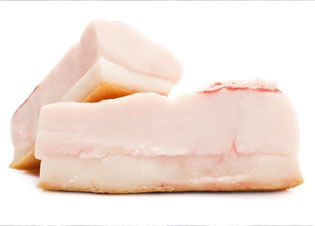
Description: It is a colorless, odorless, viscous liquid that is sweet-tasting and non-toxic. (labeled E422 in food)
Source: A byproduct of soap manufacture (normally uses animal fat)
Use: Used in FDA approved wound and burn treatments, as a sweetener in the food industry and as a humectant pharmaceutical formulations.
Alternative: Vegetable glycerin (a byproduct of vegetable oil soap), derivatives of seaweed, petroleum.
Keratin

Description: Protein extracted from various animal parts
Source: Ground-up horns, hooves, feathers, quills, and hair of various animals.
Use: In hair rinses, shampoos, permanent wave solutions.
Alternative: Almond oil, soy protein, amla oil (from the fruit of an Indian tree), human hair from salons. Rosemary and nettle give body and strand strength to hair.
Lanolin (Wool yolk)

Description: A product of the oil glands of sheep
Source: Sheep wool (See fur)
Use: Lanolin's role in nature is to protect wool and skin from climate and the environment. By humans is used as skin smoothing. It is frequently used in protective baby skin treatment and for sore nipples from breastfeeding. Lip balm, moustache wax, lubricant
Alternative: Plant and vegetable oils
Snails
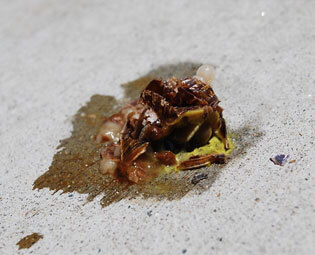
Description: Snails
Source: Crushed snails
Use: In some cosmetics
Squalene

Description: Is an organic compound. Generally any chemical compounds that contain carbon-hydrogen bonds
Source: Obtained from shark liver oil
Use: Use as an adjuvant in vaccines. Squalene is not itself an adjuvant, but it has been used in conjunction with surfactants in certain adjuvant formulations.
Alternative: Vegetable sources (primarily vegetable oils) include amaranth seed, rice bran, wheat germ, and olives.
Tallow
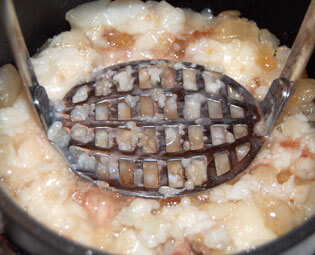
Description: Rendering is a process that converts waste animal tissue into stable, usable materials.
Source: Rendered form of beef or mutton fat, primarily made up of triglycerides.
Use: In wax paper, crayons, margarines, paints, rubber, lubricants, etc. In candles, soaps, lipsticks, shaving creams, other cosmetics
Wax

Description: Glossy, hard substance that is soft when hot.
Source: From animals and plants
Use: In lipsticks, depilatories, hair straighteners.
Alternative: Vegetable waxes
Collagen

Description: Is the main structural protein in the extracellular matrix. Connective tissues and it is the most abundant protein in mammals
Source: Tendonds or ligaments from bovine, equine, porcine, or even human sources.
Use: Widely used in cosmetic surgery, as a healing aid for burn patients for reconstruction of bone and a wide variety of dental, orthopedic, and surgical purposes
Alternative: Soy protein, almond oil, amla oil (see alternatives to Keratin), etc.
Cysteine

Description: An amino acid that can come from animals.
Source: Chicken, Cheese, Duck, Eggs, Pork, Turkey, etc.
Use: Used in hair-care products and creams, in some bakery products, and in wound-healing formulations.
Alternative: Legumes, Sunflower Seeds, Brussel sprouts, onions, garlic, bell peppers, broccoli, buckwheat and quinoa
Cystine
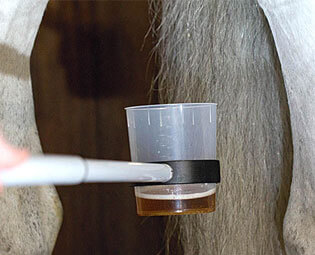
Description: An amino acid found in digestive enzymes in the cells of the immune system, in skeletal and connective tissues, skin, and hair.
Source: Found in urine and horsehair.
Use: Used as a nutritional supplement and in emollients.
Hyaluronic Acid

Description: Is an anionic, nonsulfated glycosaminoglycan distributed widely throughout connective, epithelial, and neural tissues.
Source: Extracted from the rooster comb, umbilical cords and the fluids around the joints.
Use: Used in cosmetics and some medical applications. For hydration and control inflammation
Alternative: Synthetic hyaluronic acid, plant oils.
Casein
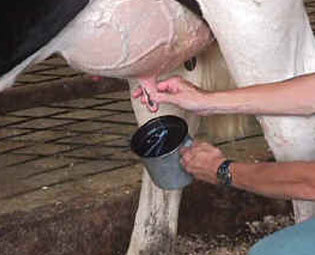
Description: Milk protein.
Source: These proteins are commonly found in mammalian milk
Use: Paint, glue, and foor
Cholesterol

Description: A steroid alcohol in all animal fats. A type of lipid. It is a yellowish crystalline solid.
Source: Nervous tissue, egg yolk, and blood. Can be derived from lanolin.
Use: In cosmetics, eye creams, shampoos, etc
Alternative: Solid complex alcohols (sterols) from plant sources
Fish oil

Description: Oil
Source: Derived from the tissues of fish species with oil in soft tissues and in the coelomic cavity around the gut
Use: Dietary supplements,
Ghee

Description: Is a class of clarified butter that originated in ancient India. Is milk fat rendered from butter to separate the milk solids and water from the butterfat.
Source: source
Use: Commonly used in cuisine of the Indian subcontinent, Middle Eastern cuisine, South Asian cuisine, traditional medicine, and religious rituals.
Alternative: Modern vegetable shortening is sometimes called 'vegetable ghee' and used for cooking, especially by vegans
Lard
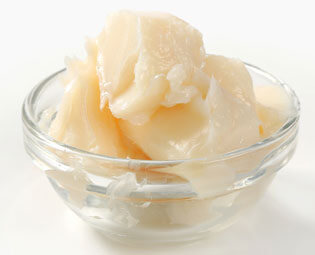
Description: Lard is a semi-solid white fat product obtained by rendering the fatty tissue of a pig.
Source: Pig
Use: Used as substitute of butter
Lipase

Description: Lipases perform essential roles in digestion, transport and processing of dietary lipids (e.g. triglycerides, fats, oils)
Source: In most, if not all, living organisms. Enzyme from the stomachs, tongue glands of calves, and lambs
Use: Used in digestive aids as it helps the body break down fats.
Alternative: Vegetable enzymes, can be from plants, fungus or yeast.
Rennet
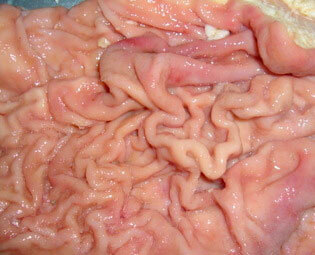
Description: Rennet is a complex set of enzymes produced in the stomachs of ruminant mammals. Chymosin, its key component, is a protease enzyme that curdles the casein in milk. In addition to chymosin, rennet contains other enzymes, such as pepsin and a lipase.
Source: Stomachs of ruminant mammals
Use: Rennet is used to separate milk into solid curds and liquid whey, and so it or a substitute is used in the production of most cheeses.
Retinol
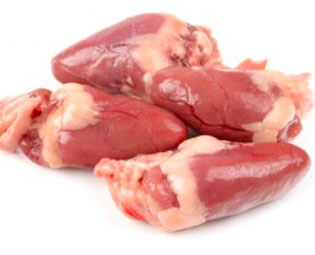
Description: Retinol, also known as vitamin A1-alcohol, is a vitamin in the vitamin A family
Source: Retinoids are found naturally only in foods of animal origin. Liver and other organs
Use: As a supplement it is ingested to treat and prevent vitamin A deficiency, especially that which results in xerophthalmia.
Shellac / Glaze

Description: Shellac is an insect produced resin
Source: Secreted by the female lac bug on trees in the forests of India and Thailand.
Use: brush-on colorant, food glaze and wood finish
Whey

Description: Whey is the liquid remaining after milk has been curdled and strained.
Source: It is a byproduct of the manufacture of cheese or casein
Use: Whey is used to produce whey cheeses such as ricotta, brunost, and whey butter and many other products for human consumption.
Lactose
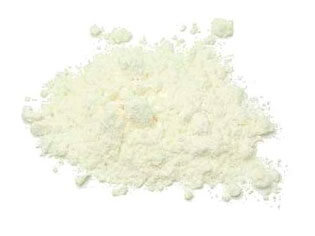
Description: It is a white compound, water-soluble with a mildly sweet taste.
Source: Lactose is only found in milk from mammals. Lactose makes up around 2–8% of milk (by weight)
Use: including drug manufacturing, food processing, and fermentation as filler or binder
Adrenaline
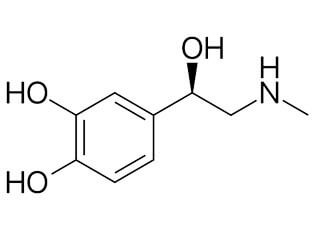
Description: Is a hormone, also known as epinephrine
Source: It is found in many animals
Use: It is used to treat a number of conditions including anaphylaxis, cardiac arrest, and superficial bleeding.
Bone Meal

Description: Is a mixture of finely and coarsely ground animal bones and slaughter-house waste products
Source: Animal bones and slaughter-house waste products
Use: It is used as an organic fertilizer for plants and as a nutritional supplement for animals.
Cortisone

Description: Cortisone is a naturally-occurring corticosteroid which is a class of steroid hormones
Source: Produced in the adrenal cortex of vertebrates, as well as the synthetic analogues of these hormones
Use: Pain relief chronic pain sufferers
Estrogen

Description: Estrogen, or oestrogen, is a category of sex hormone responsible for the development and regulation of the female reproductive system and secondary sex characteristics
Source: Meat, Dairy, and Eggs
Use: Menopausal hormone therapy, hormonal birth control and feminizing hormone therapy for transgender women and nonbinary people
Linoleic Acid

Description: It is a fatty acid. The word 'linoleic' derives from the Latin linum 'flax' + oleum 'oil', reflecting the fact that it was first isolated from linseed oil.
Source: Mainly found in plant oils. non-vegan sources come from Egg Yolk, Lard, Butter, Chicken fat
Use: oil paints and varnishes
Pepsin

Description: Is an aspartic protease which is a catalytic type of protease enzymes that use an activated water molecule bound to one or more aspartate residues for catalysis of their peptide substrates
Source: It is produced in the gastric chief cells of the stomach lining and is one of the main digestive enzymes in the digestive systems of humans and many other animals
Use: Treat stomach ulcers and other pepsin-related conditions, also inhibits pepsin activity
Chondroitin

Description: Bluish-white gelatin-like substance, being a protein-carbohydrate complex and can be obtained by boiling cartilage in water.
Source: Animal tissue, especially connective tissues. Gristle on animal bones is high in chondroitin. Some chondroitin supplements come from animal sources, like shark or beef cartilage
Use: Supplement used in treating the joint disease of osteoarthritis as well as glucosamine
Estradiol
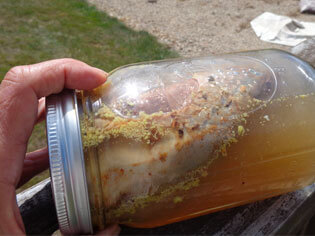
Description: Is an estrogen steroid hormone and the major female sex hormone. It is involved in the regulation of the estrous and menstrual female reproductive cycles
Source: Female hormones from pregnant mares’ urine
Use: primarily in hormone therapy for menopausal symptoms as well as transgender hormone replacement therapy
Glucosamine

Description: Glucosamine is a natural compound found in cartilage — the tough tissue that cushions joints.
Source: Harvested from shells of shellfish or made in a lab
Use: Treat a painful condition caused by the inflammation, breakdown and eventual loss of cartilage (osteoarthritis)
Disodium Inosinate (E630)

Description: Is the disodium salt of inosinic acid.
Source: It is typically obtained from chicken byproducts or other meat industry waste
Use: Widely used as a flavor enhancer
Trypsin

Description: (EC 3.4.21.4)
Source: found in the digestive system of many vertebrates. First isolated by rubbing the pancreas with of pork with glycerin
Use: Used widely in various biotechnological processes. Break down casein in breast milk, dissolve blood clots, dissolve dead tissue and pus in wounds in horses, cattle, dogs, and cats
Captopril

Description: sold under the brand name Capoten among others, is an angiotensin-converting enzyme (ACE) inhibitor
Source: Pit viper's venom
Use: Treatment of hypertension and some types of congestive heart failure
Exendin-4

Description: The component of the Gila monster’s venom is a peptide known as exendin-4
Source: Gila monster’s venom
Use: Alzheimer’s disease, diabetes, and other diseases common to older age
Limulus Amebocyte Lysate (LAL)

Description: Is an aqueous extract of blood cells (amoebocytes)
Source: Blood cells of the Atlantic horseshoe crab
Use: Detect presence of bacterial endotoxins in drugs and biological products
Heparin

Description: Heparin, also known as unfractionated heparin (UFH), is a medication and naturally occurring glycosaminoglycan.
Source: Pharmaceutical-grade heparin is derived from mucosal tissues of slaughtered meat animals such as porcine (pig) intestines or bovine (cattle) lungs.
Use: As a medication it is used as an anticoagulant (blood thinner). Treatment of heart attacks and unstable angina
Chinese Hamster Ovary Cells (CHO Cells)

Description: Epithelial cell line
Source: Derived from the ovary of the Chinese hamster
Use: CHO cells are the most common mammalian cell line used for mass production of therapeutic proteins
Cashmere

Description: Cashmere wool, usually simply known as cashmere, is a fiber
Source: Obtained from cashmere goats, pashmina goats, and some other breeds of goat
Use: Used for clothing and other textile articles
Down
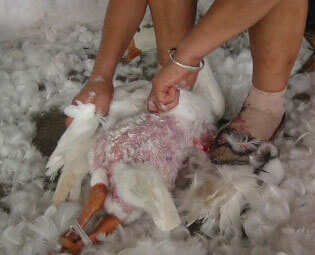
Description: The down of birds is a layer of fine feathers found under the tougher exterior feathers.
Source: Post mortem (after slaughter), gathering and live plucking on ducks and geese. 80% of down and feathers used globally are produced in china, 90% comes from ducks.
Use: Used in goods such as jackets, bedding (duvets), pillows and sleeping bags
Feathers

Description: Feathers are epidermal growths that form a distinctive outer covering, or plumage.
Source: Geese and Ducks. Post mortem (after slaughter), gathering and live plucking
Use: Bedding, especially pillows, blankets, mattresses, and clothing
Feather Meal

Description: It is made from poultry feathers by partially grinding them under elevated heat and pressure, and then grinding and drying.
Source: Byproduct of processing poultry
Use: Used in formulated animal feed and in organic fertilizer.
Fur

Description: Fur is a thick growth of hair that covers the skin of many different animals. It is a defining characteristic of mammals
Source: Common source include fox, rabbit, mink, beaver, ermine, otter, sable, seal, coyote, chinchilla, raccoon, and possum
Use: clothing
Leather

Description: Animal skins
Source: 99% of the skins used in the production of leather derive from animals raised for meat and/or dairy production
Use: Used to make a variety of articles, including footwear, automobile seats, clothing, bags, book bindings, fashion accessories, and furniture
Silk

Description: Silk is a natural protein Fiber or fibre is a natural or man-made substance that is significantly longer than it is wide
Source: The protein fiber of silk is composed mainly of fibroin and is produced by certain insect larvae to form cocoons. Synthetic fibers can often be produced very cheaply and in large amounts compared to natural fibers
Use: Used for clothing such as shirts, ties, blouses, formal dresses
Suede

Description: Suede is made from the underside of the animal skin, which is softer and more pliable than the outer skin layer
Source: Primariliy from lamb, although goat, calf, and deer are commonly used
Use: Accessories, clothing or shoes
Alternative: Synthetic fabrics are often manufactured with a brushed or napped finish to resemble suede leather
Wool

Description: Animal fur
Source: Obtained from sheep and other animals, including cashmere and mohair from goats
Use: In addition to clothing, wool has been used for blankets, horse rugs, saddle cloths, carpeting, insulation and upholstery
Alternative: Synthetic fabrics
Animal Derived Ingredients List
Animal Derived Ingredients Categories
Easy Vegan Swaps
Switching to a vegan diet can seem very daunting, it is actually much easier than you might think.
Help 5 Vegan grow
Your support fuels our growth, no contribution is too small.

